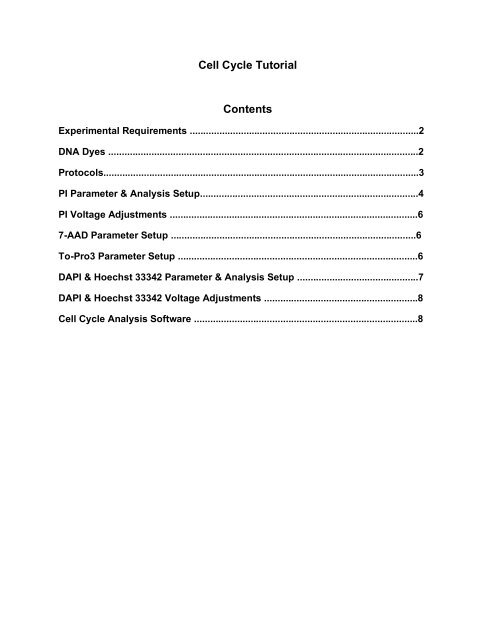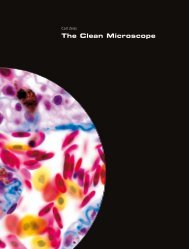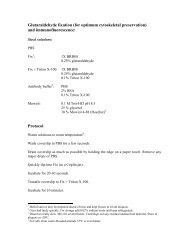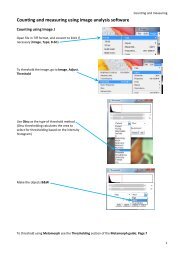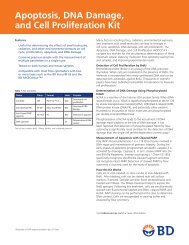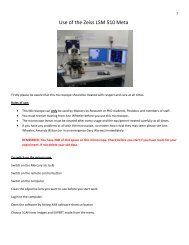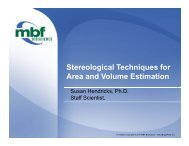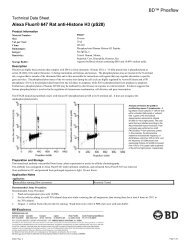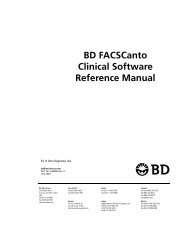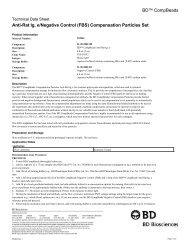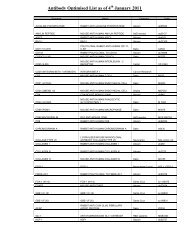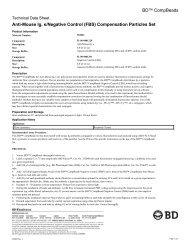Cell Cycle Tutorial Contents
Cell Cycle Tutorial Contents
Cell Cycle Tutorial Contents
Create successful ePaper yourself
Turn your PDF publications into a flip-book with our unique Google optimized e-Paper software.
<strong>Cell</strong> <strong>Cycle</strong> <strong>Tutorial</strong><strong>Contents</strong>Experimental Requirements .....................................................................................2DNA Dyes ...................................................................................................................2Protocols.....................................................................................................................3PI Parameter & Analysis Setup.................................................................................4PI Voltage Adjustments ............................................................................................67-AAD Parameter Setup ...........................................................................................6To-Pro3 Parameter Setup .........................................................................................6DAPI & Hoechst 33342 Parameter & Analysis Setup .............................................7DAPI & Hoechst 33342 Voltage Adjustments .........................................................8<strong>Cell</strong> <strong>Cycle</strong> Analysis Software ...................................................................................8
Experimental Requirements1. <strong>Cell</strong>s in suspension2. 70% ice-cold ethanol3. PBS4. RNase5. 37 o C incubator6. DNA dye of choice e.g. PI, DAPI, 7-AAD, Hoechst 333427. Flow Cytometer, BD LSRII or BD FACSCanto IIDNA DyesThere are numerous fluorescent DNA dyes used for multiple purposes not all aresuitable for flow cytometric cell cycle analysis. Only fluorescent DNA dyes that bind toDNA in a linear manner can be used for flow cytometric analysis of the cell cycle. Thusas DNA content of a cell increases the fluorescent signal from the DNA dye increasesproportionally in a linear manner.Commonly used DNA dyes used for flow cytometric cell cycle analysis includepropidium iodide (PI), 4’,6-Diamidino-2-phenylindole dihydrocloride (DAPI), 7-aminoactinomycinD (7-AAD), ToPro-3 and Hoechst 33342. There are numerous other dyessuch as Sytox16 a green fluorescent DNA dye as well as other live cell cycle dyes, suchas DRAQ5, and the new range of dyes from Invitrogen.The common dyes, PI ex 350 & 488nm em 619nm, 7-AAD ex 488nm em 650nm,ToPro-3 ex 633nm em 660nm and DAPI ex 350nm em 461nm are for use with ethanolfixed cells only. Hoechst 33342 ex 350 nm em 461nm is the commonly used DNA dyefor live cell cycle analysis.PI is normally used at 50 µg/ml, 7-AAD at 25 µg/ml, ToPro-3 10nM, DAPI at 1µg/ml.Hoechst 33342 titrated for each cell type and has to be incubated with live cells at 37 o Cfor varying times for each cell type. A reasonable starting point for most cells is 10 µg/mlfor 45 minutes at 37 o C.
Fixed <strong>Cell</strong> Staining Protocols for PI, 7-AAD, ToPro-3 and DAPI1. Harvest cells washing in PBS.2. Fix pelleted cells in ice-cold 70% ethanol by adding with a Pasteur pipette on avortex. Leave cells at 4 o C from 30 mins to a week.3. Pellet cells at approximately 2,000 rpm for 5 mins. Wash twice in PBS.4. Pellet cells, wash twice in PBS.5. Add 50 µl RNAse (100 µg/ml Sigma) and incubate at RT or 37 o C for 15 mins.6. Add 200 µl of PI (50 µg/ml Sigma P4170); or 7-AAD (25 µg/ml Sigma); orToPro-3 (10 nM Invitrogen); or DAPI (1 µg/ml Sigma).7. Analyse by flow cytometry collecting 25,000 events per sample.Live <strong>Cell</strong> <strong>Cycle</strong> Analysis with Hoechst 333421. Harvest cells washing in PBS.2. Add 10 µg/ml Hoechst 33342 to cells incubate at 37 o C for 45 minutes3. Transfer cells to Falcon 5 ml tubes4. Add 5 µg/ml PI for viability5. Analyse by flow cytometry collecting 25,000 events per sample.
PI Parameter and Analysis SetupPI can be detected in the 575/26 nm, 610/20nm and 670/14nm channels on the BDLSRII and the 575/26nm channel on the BD FACSCanto II.The parameter setup for cell cycle analysis is special setup compared toimmunophenotyping. Aggregates of G 1 cells have the same DNA content as G 2 m cells,to distinguish these the instrument can separate these by measuring the time it takes forthe two types of cells to pass through the laser beam by a fluorescent parameter widthmeasurement. Aggregates of cells take longer to pass through the laser of the flowcytometer and thus appear higher up on the fluorescent width scale, see diagrambelow.PE 575/26nm Channel <strong>Cell</strong> <strong>Cycle</strong> AnalysisFig 1aFig 1bInitial cell population gating is placed on FSC v SSC (cell size v granularity) (Fig1a).This cell population gate is then placed on PE 575/26nm-W(idth) v PE 575/26nm-A(rea)plot (Fig1b). Doublets appear to the right of single cell analysis gate P2. Single cell gateP2 is then displayed as a histogram using PE 575/26nm-A parameter (Fig2)Fig2
Standard cell cycle analysis of the cell cycle profile is shown in Fig2 with gates P4, P5and P6 gating on G 1 , S phase and G 2 m with 46%, 22% and 21% respectively.PE-Texas Red 610/10nm Channel <strong>Cell</strong> <strong>Cycle</strong> AnalysisFig 3aFig 3bFigure 3 a and b shows the parameter display when using the PE-Texas-Red Channelfor detection of PI.Fig 4Standard cell cycle analysis of the cell cycle profile is shown in Fig2 with gates P4, P5and P6 gating on G 1 , S phase and G 2 m with 78%, 13% and 8% respectively.
PI Voltage AdjustmentsFor clinical use of flow cytometric cell cycle analysis cells should be counted and thevolume of PI solution adjusted so all samples have the same number of cells pervolume. For easy analysis of research samples (not clinical) the voltage (see highlightedarea in figure 5) on the PE 575/26nm-A or PE-Texas-Red 610/20-A can be altered fromone sample to the next to place the G 1 in the same position for each sample. Thisallows the researcher to not move the gates when analysing the data making the datamore reproducible, see Figure 5 below.Fig 57-AAD Parameter SetupThe parameter setup when using 7-AAD is as described above but using the PE-Cy5670/20 nm channel on the BD LSRII or the 650LP nm channel on the BD FACSCanto II.To-Pro3 Parameter SetupThe parameter setup when using To-Pro-3 is as described above but using the APC660/20 nm channel on the BD LSRII and the BD FACSCanto II.
DAPI & Hoechst 33342 Parameter & Analysis SetupDAPI and Hoechst 33342 have similar excitation and emission profiles so the parametersetup is using the UV 440/40nm channel on the BD LSRII. This procedure cannot becarried out well on the violet 440/40nm channel on the BD LSRII or the BD FACSCantoII .The analysis setup for DAPI is shown below in Figure 6 using the Area and Widthparameters on the UV 440/40nm channel on the BD LSRII.Fig 6aFig 6bThe final analysis of the cell cycle profile is shown in Fig7 with gates P4, P5 and P6gating on G 1 , S phase and G 2 m with 73%, 7% and 14% respectively.Fig 7
DAPI & Hoechst 33342 Voltage AdjustmentsFor easy analysis of research samples the voltage on the UV 440/40nm-A can bealtered from one sample to the next to place the G 1 in the same position for eachsample. This allows the researcher to not move the gates when analysing the datamaking the data more reproducible.<strong>Cell</strong> <strong>Cycle</strong> Analysis Software<strong>Cell</strong> <strong>Cycle</strong> analysis of research samples can be adequately done by the straight lineargating as illustrated above. If the research requires more stringent analysis the FlowCytometry Core Facility has deconvolution software that allows the investigator tocalculate the area under the curve for G 1 , S phase and G 2 m. The tree Star inc softwareFlowJo has numerous special analysis platforms purpose made for flow cytometricanalysis. The <strong>Cell</strong> <strong>Cycle</strong> Platform employs two mathematical models the Dean/Jet/Foxanalysis and the Watson Pragmatic, see example below in figure 8a and b.Fig 8aFig 8b25002000# <strong>Cell</strong>s150010005007514.311.400 50K 100K 150K 200K 250KUV 440/40nm-AFigure 8a shows cell cycle data analysed in the standard manner. Figure 8b showsanalysis by FlowJo models Watson Pragmatic and Dean/Jett/Fox algorithms.Please note that no software models can analyse Sub G 1 data for estimations ofapoptosis.


